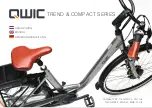
SECTION: IV Tech
15
Fig 6
Turning the tension adjusting nut clockwise while keeping the
cam lever from rotating increases clamping force; turning it
counterclockwise while keeping the cam lever from rotating
reduces clamping force. Less than half a turn of the tension
adjusting nut can make the difference between safe clamping
force and unsafe clamping force.
b.
Front Wheel Secondary Retention Devices.
Most bicycles
have front forks which utilize a secondary wheel retention
device to keep the wheel from disengaging if the quick release
is incorrectly adjusted. Secondary retention devices are not a
substitute for correct quick release adjustment.
Secondary retention devices fall into two basic categories:
1.
The clip-on type is a part which the manufacturer adds to
the front wheel hub or front fork.
2.
The integral type is molded, cast or machined into the
outer faces of the front fork dropouts.
Ask your dealer to explain the particular secondary retention
device on your bike.
WARNING:
Removing or disabling the secondary retention device is
extremely dangerous and may lead to serious injury or death. It also may void
the warranty.
2. Removing and Installing Quick Release Wheels
a.
Removing a Quick Release Front Wheel
1.
If your bike has rim brakes, disengage the brake’s quick-
release mechanism to open the clearance between the wheel
rim and the brake pads (See Section IV.C. Fig. 11 – 14).
2.
Move the wheel’s quick-release lever from the locked or
CLOSED position to the OPEN position (Figs. 7a & b).
3.
If your front fork does not have a secondary retention
device go to step (5).
4.
If your front fork has a clip-on type secondary retention
device, disengage it and go to step (5). If your front fork
has an integral secondary retention device, loosen the
tension adjusting nut enough to allow removing the wheel;
then go to the next step.
18
SECTION: IV Tech
brake pads; then squeeze the brake lever and make sure
that the brakes are operating correctly.
3. Removing and Installing Bolt-On Wheels
a. Removing a Bolt-On Front Wheel
1.
If your bike has rim brakes, disengage the brake’s quick-
release mechanism to open the clearance between the wheel
rim and the brake pads (see Section IV.C., Ffigs. 11 – 14).
2.
Using a correct size wrench, loosen the two axle nuts.
3.
If your front fork has a clip-on type secondary retention
device, disengage it and go to he next
step. If your front fork has an integral
secondary retention device, loosen the
axle nuts enough to allow wheel removal;
then go to the next step.
4.
Raise the front wheel a few inches off the
ground and tap the top of the wheel
with the palm of your hand to knock the
wheel out of the fork ends.
b. Installing a Bolt-On Front Wheel
1.
With the steering fork facing forward, insert the wheel
between the fork blades so that the axle seats firmly at the
top of the slots which are at the tips of the fork blades. The
axle nut washers should be on the outside, between the
fork blade and the axle nut. If your bike has a clip-on type
secondary retention device, engage it.
2.
While pushing the wheel firmly to the top of the slots in the
fork dropouts, and at the same time centering the wheel
rim in the fork, use the correct size wrench to tighten the
axle nuts as tight as you can.
3.
Re-engage the brake quick-release mechanism to restore
correct brake pad-to-rim clearance; spin the wheel to
make sure that it is centered in the frame and clears the
brake pads; then squeeze the brake lever and make sure
that the brakes are operating correctly.
c. Removing a Bolt-On Rear Wheel
WARNING:
If your bike is equipped with an internal gear rear hub, do not
attempt to remove the rear wheel. The removal and re-installation of internal
gear hubs require special knowledge. Incorrect removal or assembly can
result in hub failure, which can cause you to lose control and fall.
1.
If your bike has rim brakes, disengage the brake’s quick-
release mechanism to open the clearance between the wheel
rim and the brake pads (see Section IV.C, Figs. 11 – 14).
2.
Shift the rear derailleur to high gear (the smallest rear
sprocket) and pull the derailleur body back with your
right hand.
3.
Using the correct size wrench, loosen the two axle nuts.
Fig. 8

































